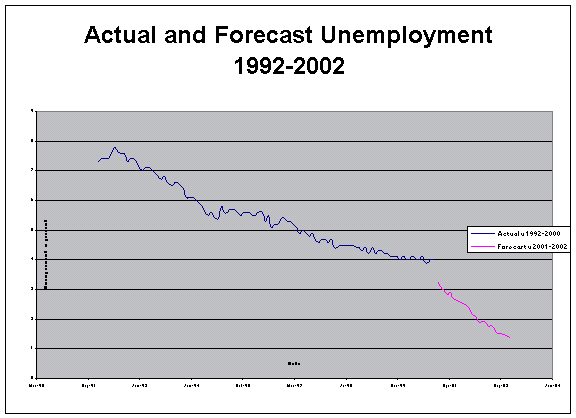

NICOLE ROOT and DANIELLE FOURNIER
College of Business
Abstract
The U.S. Employment rate is expected to be between 3.9% and 4.4% for the next two years. This forecast is based on the Keynesian Aggregate Expenditure Model using Real Personal Consumption Expenditures as explanatory variables and the Civilian Unemployment Rate. The correlation between unemployment and consumption was very strong. The forecasting regression adjusted R-square indicated 95% of the variation in unemployment is explained by variation in the consumption variable. Workers and employers should expect current favorable job conditions to stay about the same over the next two years. (JEL: E24, E66)
Part 1. Introduction
This paper forecasts the monthly unemployment rate for the years 2001 and 2002. The sample period for the data is from the first month of 1990 to the eleventh month of 2000. The forecast horizon is two years into the future. The explanatory variable is consumption spending. The approach is based on the Keynesian Aggregate Expenditure Model.
The prediction of the unemployment rate is important because it directly effects the economy and the people of the United States. Government sponsored programs such as Welfare, Medicaid, and others dealing with low-income families can use this information to forecast future budgets and trends. As consumption spending increases, unemployment decreases. The retailing sector will be interested in the results to develop a successful strategy for adjusting to the unemployment rate. The more income consumers have, the higher consumption spending will be. As citizens are planning to enter the workforce, this two-year forecast will be useful. This forecast horizon was chosen to keep the data as accurate as possible when taking the lag period into account.
The rest of this paper is organized as follows: part 2. presents the data used to forecast the unemployment rate; part 3. presents the theoretical basis for the approach adopted in forecasting the unemployment rate; part 4. presents forecasts of unemployment for 2001 and 2002; part 5. evaluates the importance of the economy; and part 6. discusses conclusions for economic policy.
Part 2. Data
This forecast assumes the unemployment rate will continue to go down for the next two years and will have an impact on consumption spending. Other variables held constant. It seems that the data generated is theoretically correct but practically impossible for unemployment to ever get as low as our forecast. The reasoning behind this is the lagged data. The prediction of the consumption will be determined by the Keynesian Consumption function which is:
U=f(C)
After lagging the right-hand side of the equation two years, the forecasting equation is written as:
Ut=A0+A1(Ut-2)+A2(Ct-2)
Part 4. Empirical Results:A Short Term Projection of U.S. Unemployment 2001-2002
The unemployment
forecasting equation 1 was estimated with 1992-2002 monthly data.
The Least Squares Regression Method was used. The results from the
regression are shown in Table 1.
|
Explanatory Variable
|
Estimated Coefficient
|
T-statistic
|
|
Intercept
|
25.962
|
35.52
|
|
u(t-2)
|
-0.4941
|
-11.29
|
|
C(t-2)
|
-0.003534
|
-34.56
|
|
R Square
|
0.9467
|
Prob F = 0.000
|
The adjusted R2 is .946694, indicating approximately 95% of the variation in unemployment is explained by consumption spending.

This forecast projects the unemployment rate to fall as consumption spending rises. These unemployment rates are very favorable for the economy.
Part 5. A Rosy Outlook
U.S. citizens and the government can use the forecast of unemployment for estimating and making decisions about a broad range of activities. This paper forecasts unemployment to go beyond the natural rate of unemployment. It may very well decrease considerably, but it will not reach zero and certainly will not fall into the negative range. After several years of an economic high, unemployment still remains low, therefore this forecast is favorable because it predicts a continuation of low unemployment at least two years into the future. The unemployment rate high and low ranges for the period of 2001 to 2002 are 4.4% and 3.3%. As a result of this forecast, government spending on unemployment programs should remain relatively unchanged from current levels. This means current markets for unemployment should remain strong and individuals looking for future employment should not have much trouble finding work. It also implies tight labor markets are not expected to loosen up for the next two years.